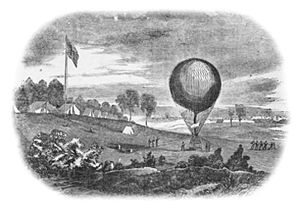Union Army Balloon Corps
| Union Army Balloon Corps | |
|---|---|

Woodblock sketch of Lowe's balloon with McClellan's Army of the Potomac as depicted in Harper's Weekly.
|
|
| Active | October 1861 – August 1863 |
| Country |
|
| Allegiance | Union |
| Branch | Army |
| Type | Aviation |
| Role | Aerial reconnaissance |
| Size | 8 aeronauts |
| Part of | Topographical Engineers (civilian contract) |
| Garrison/HQ | Fort Corcoran, Va. |
| Equipment | 7 aerostats with hydrogen gas generators |
| Engagements | Bull Run Yorktown Fair Oaks Vicksburg |
| Commanders | |
| Notable commanders |
Thaddeus S. C. Lowe (Chief Aeronaut) |
The Union Army Balloon Corps was a branch of the Union Army during the American Civil War, established by presidential appointee Thaddeus S. C. Lowe. It was organized as a civilian operation, which employed a group of prominent American aeronauts and seven specially built, gas-filled balloons to perform aerial reconnaissance on the Confederate States Army.
Lowe was one of few veteran balloonists who was working on an attempt to make a transatlantic crossing by balloon. His efforts were interrupted by the onset of the Civil War, which broke out one week before one of his most important test flights. Subsequently, he offered his aviation expertise to the development of an air-war mechanism through the use of aerostats for reconnaissance purposes. Lowe met with U.S. President Abraham Lincoln on June 11, 1861, and proposed a demonstration with his own balloon, the Enterprise, from the lawn of the armory directly across the street from the White House. From a height of 500 feet (150 m) he telegraphed a message to the President describing his view of the Washington, D.C., countryside. Eventually he was chosen over other candidates to be chief aeronaut of the newly formed Union Army Balloon Corps.
The Balloon Corps with a hand-selected team of expert aeronauts served at Yorktown, Seven Pines, Antietam, Fredericksburg, and other major battles of the Potomac River and the Virginia Peninsula. The Balloon Corps served the Union Army from October 1861 until the summer of 1863, when it was disbanded following the resignation of Lowe.
...
Wikipedia
